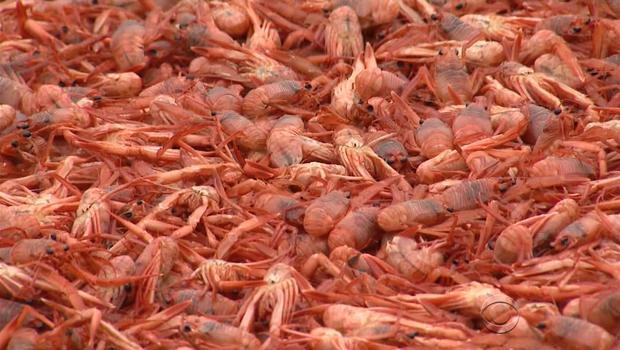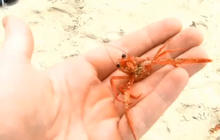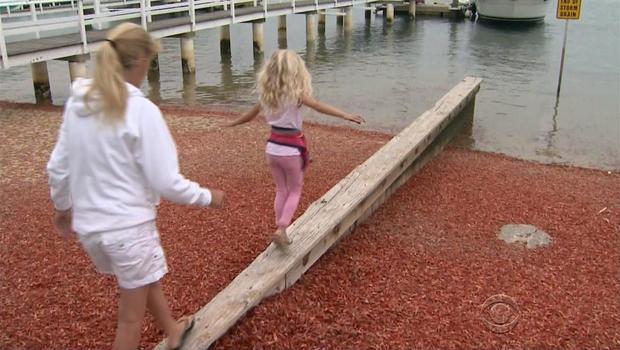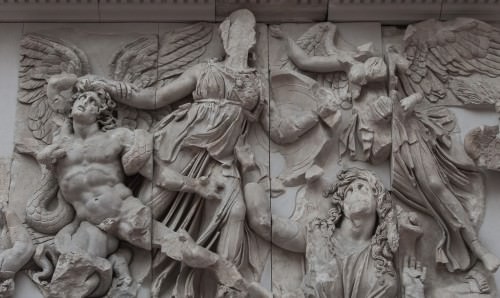Εκατομμύρια κόκκινα καβούρια τόνου εισβάλει Καλιφόρνια παραλίες
ΛΟΣ ΑΝΤΖΕΛΕΣ - Είναι μια κόκκινη παλίρροια κατά μήκος της ακτής της Νότιας Καλιφόρνιας, όπως τα εκατομμύρια των κόκκινων καβουριών τόνουφαίνεται να έρχεται στην ξηρά. Οι επιστήμονες λένε ότι είναι ένα ασυνήθιστο θέαμα που θα μπορούσε να είναι ένα σημάδι των μεγάλων αλλαγών που προβλέπονται για τις καιρικές συνθήκες.
Τα μικροσκοπικά καβούρια τόνου είναι τόσο πυκνή σε μέρη που ο Johnny Fotsch έπρεπε να καταργήσετε μια διαδρομή με το κουπί του.
"Έμοιαζε με ένα κόκκινο χαλί - ένα καλό πόδι-να-16 ίντσες παχιά», είπε. «Είναι κάπως Μου πήρε λίγο πίσω, γιατί ποτέ δεν έχω δει κάτι τέτοιο πριν.
Οι καραβίδες που μοιάζει με ένα έως τρία καβούρια ιντσών έχει το πλύσιμο στην ξηρά από τις χιλιάδες για τρεις ημέρες. Γειτονιά παραλία Anita Rovsek για Balboa Island έχει καλυφθεί.
Τα καβούρια ήταν παχιά στις ακτές της Balboa Island.
CBS NEWS
«Όταν τους είδα για πρώτη φορά, δεν ξέραμε τι ήταν», είπε. «Και όλοι ήταν εκεί κάτω προσπαθώντας να τους σώσει. - Ρίχνουν τους πίσω στο"
Το φυσικό τους ενδιαίτημα είναι κοντά Μπάχα Καλιφόρνια. Αλλά οι επιστήμονες πιστεύουν ότι το ζεστό νερό αντλώντας τα καβούρια βορειότερα. Ασυνήθιστο και μέχρι στιγμής ανεξήγητη ζεστά επιθέματα στον Ειρηνικό εκτείνονται τώρα από τη νότια Καλιφόρνια σε όλη τη διαδρομή προς τον Κόλπο της Αλάσκα και τη θάλασσα του Μπάρεντς.
«Εμείς συνήθως δεν δείτε αυτά τα ζώα, επειδή ζουν στον πυθμένα της υφαλοκρηπίδας", δήλωσε ο θαλάσσιος βιολόγος Mike Schaadt.
Δεν είναι μόνο τα καβούρια που κατευθύνονται βόρεια αλλά και μεγάλα κοπάδια τόνου.
"Θα μπορούσε κάλλιστα να είναι ότι αυτά τόνου έχουν ακολουθήσει τα κόκκινα καβούρια μέχρι. Επειδή αυτό είναι μια πηγή τροφίμων που είναι στη διάθεσή τους. Και αυτά είναι γρήγορη κίνηση αρπακτικών ψαριών και πρόκειται να πάει εκεί όπου η τροφή είναι," είπε ο Schaadt.
Χιλιάδες κόκκινα καβούρια τόνου εισβάλουν παραλίες στο Orange County, Καλιφόρνια.
CBS ΛΟΣ ΆΝΤΖΕΛΕΣ
Η τελευταία φορά που τα καβούρια τόνου εμφανίστηκε σαν αυτό ήταν το 1997 ... ακριβώς πριν από μια μαζική Ελ Νίνιο, μια αύξηση της θερμοκρασίας του Ειρηνικού νερά που προκαλεί αλλαγές στην ατμόσφαιρα.
Το Ελ Νίνιο προκάλεσε μηνών από πλημμύρες και κατολισθήσεις στην Καλιφόρνια. Αν ένα υγρό χειμώνα θα είναι ευπρόσδεκτοι εδώ στην ξηρασία κατέστρεψαν Καλιφόρνια, οι επιστήμονες λένε ότι αυτό θα μπορούσε να είναι μια κόκκινη οιωνός που ένας χειμώνας Ελ Νίνιο είναι μπροστά.
Φυσικά ένα βροχερό χειμώνα θα είναι ευπρόσδεκτοι εδώ στην ξηρασία κατέστρεψαν Καλιφόρνια. Αλλά για τώρα, αυτά τα καβούρια είναι αρκετά μια αηδία. Και αυτό είναι gonna παίρνει πολύ για να καθαρίσει όλο αυτό επάνω. Και σε περίπτωση που αναρωτιέστε, ναι, η μυρωδιά είναι τρομερό.
CBS NEWS























